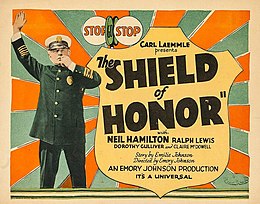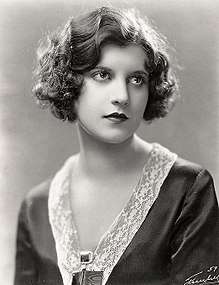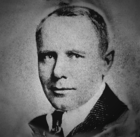The Shield of Honor
The Shield of Honor is a 1927 American silent crime drama film directed by Emory Johnson based on the original story by Emilie Johnson. It starred Neil Hamilton, Dorothy Gulliver, and Ralph Lewis. This film explores a new branch of law enforcement - the Sky Cops. We follow the story of Jack MacDowell, the department's first pilot. Jack during the course of his new duties, acquiries a love interest and enlists the help of his retired father. They all work together attempting to solve a series of diamond heists. Jack and his father deal with burning buildings, exchanging gunfire with jewel thieves and a spectacular aerial battle. They finally arrest the perpetrators. Following its New York City premiere on December 10, 1927, the film was released on February 18, 1928, by Universal Pictures.[1][2]
| The Shield of Honor | |
|---|---|
 Lobby card | |
| Directed by | Emory Johnson |
| Produced by | Universal Pictures Jewel |
| Written by |
|
| Based on | Story by Emilie Johnson |
| Starring | |
| Cinematography | Ross Fisher |
| Color process | Black and White |
| Distributed by | Universal Pictures |
Release date |
|
Running time | 6 reels |
| Country | United States |
| Language | Silent (English intertitles |
Plot
This film opens with veteran police officers Dan MacDowell (Ralph Lewis), and his son Jack MacDowell (Neil Hamilton) attending a ceremony. The event is celebrating the addition of a new airplane to the law enforcement group. Jack MacDowell will become the police plane's first flying officer. Also, participating in the celebration is Gwen O'Day (Dorothy Gulliver). She is the daughter of a wealthy jeweler named Howard O'Day (Fred Esmelton). Gwen is chosen to christen the new police plane with a bottle of Champaign. During the christening, Jack MacDowell develops a fascination for beautiful Gwen. The feeling is mutual. The celebration culminates with a review of the force.

After the conclusion of the ceremony, we find another major jewel robbery that has happened in the city. We further discover that only O'Day's customers were the victims of burglaries. Somehow, all the robberies trace back the O'Day jewelry store. All the thieves remain unsolved. Howard is determined to solve these crimes, but can't make any headway on his own. Howard asks Jack MacDowell if he can do a police investigation the diamond thefts. Gwen overhears her father's request and secretly asks if she can assist too.
Meanwhile, Dan MacDowell turns sixty-five. Under police department regulations, this is the mandatory age of retirement from the police force. Dan is forced to retire. Even though he is retired, Dan still wants to be involved in law enforcement. Howard O'Day gives Dan a security job at the jewelry store. He is the new night watchman.
Jack and Gwen continue to hunt for clues about the jewel thefts. In addition to his watchman duties, Dan MacDowell is also assisting in detective work. After investigating several clues, Jack whittles his suspect list down to one man, Howard's business advisor, Robert Chandler, played by Nigel Barrie. But Jack and Gwen still haven't gathered enough evidence to press charges. Unbeknown to Jack and Gwen, Robert Chandler is the leader of a gang of jewel thieves. Other members of the group include Rose Fisher (Thelma Todd), O'Day's stenographer and Red (David Kirby) the store janitor. They have a straightforward plan. Steal from the jewelry store customer, then sell the jewels back to the store.
Jack and Gwen continue their investigation. Then another burglary is carried out. This time they rob the actual O'Day jewelry store of precious diamonds. During the commission of the crime, Gwen discovers the thieves; they, in turn, lock her in the vault and set the building on fire. The thieves make their escape and board a waiting plane. They will make their escape in the air. Jack catches wind of the robbery, but this time, he knows who did it. Jack and his father rush to the police plane, jump in the cockpit, strap up and take to the air. They give chase to the fugitive's plane. After catching up with the criminals, a night aerial battle takes place. When the smoke settles, the jewel thieves are rounded up and arrested. We confirm Chandler is the leader of a gang of jewel thieves.
Jack MacDowell, the department's first aviator detective, has proven the worth of an airplane in law enforcement. He becomes the shining example of the newest branch of the law - the Sky Cops. Even though Dan MacDowell is Sixty-five, the department waives the mandatory retirement, and he is allowed to rejoin the force. Jack is a hero and marries Gwen.
Cast
Actor Role Neil Hamilton Jack MacDowell Dorothy Gulliver Gwen O'Day Ralph Lewis Dan MacDowell Nigel Barrie Robert Chandler Claire McDowell Mrs. MacDowell Fred Esmelton Howard O'Day Harry Northrup A. E. Blair Thelma Todd Rose Fisher David Kirby Red Joseph W. Girard Chief of Police William Bakewell Jerry MacDowell Hank himself, a dog
Pre-production
Marketing
Based on an American Film Institute standard, films with a running time of forty-five minutes or longer are considered feature films. In 1915, feature films were becoming more the trend in Hollywood. In 1916, Universal formed a three-tier branding system for their releases. Universal films decided to label their films according to the size of their budget and status. Bear in mind, Universal, unlike the top-tier studios, did not own any theaters to market its feature films. By branding their product, Universal gave theater owners and audiences a quick reference guide. Branding would assist theater owners in making a judgment for films they were about to lease and help fans decide which movies they wanted to see.
Universal released three different types of feature motion pictures:[3][4]
- Red feather Photoplays – low budget feature films
- Bluebird Photoplays – Mainstream feature release and more ambitious productions
- Jewel – prestige motion pictures featuring big budgets using prominent actors
This film carried Universal’s “Jewel” branding, designating top-shelf motion pictures featuring big budgets with all-star casts.
Theme
This film is the second effort by Emory Johnson to glorify the brave men in blue. The first film to start the series of "Glorifying the men in uniform" men in uniform" was In the Name of the Law. This film, along with showing their everyday dedication to duty, also interweaves love, adventure and a series of crimes.
Screenplay
Emilie Johnson was Emory Johnson's mother. She developed the stories for the majority of films directed by her son. The basis of this film was the original Emilie Johnson story In the Name of the Law. By the time this film was produced, Emilie Johnson was no longer writing screenplays. Adaption and screenwriting duties fell to a team of three writers, Leigh Jacobson, Gladys Lehman and Viola Brothers Shore.
Casting
Ralph Lewis was cast as the veteran 65-year old policeman Dan MacDowell. Casting Lewis in this role made sense since he was featured prominently in the Emory Johnson 1922 production of In the Name of the Law. In that film, he played policeman Pat O'Hara. Lewis was now 55 years old, which is to say he was too old for a leading man. In another ironic twist Claire McDowell plays Dan MacDowell's wife. In the 1922 film In the Name of the Law she played the wife of Pat O'Hara. 28-year-oldJames Neil Hamilton received the starring role of Jack MacDowell. 19-year-old Dorothy Gulliver earned the role of Leading lady Gwen O'Day.
Production
Location
Filming the externals for this film took place in Exposition Park located in Los Angeles. The remainder of the filming was at Universal Studios located at 100 Universal City Plaza in Universal City, California.
Post-production
The theatrical release of this film totaled six reels or 6,173 feet of film. As is often the case, the listed time for this feature-length movie varies. At the time, the average time per 1,000-foot 35mm reel varied between ten and fifteen minutes per reel. Thus, the total time for this movie is computed between sixty and eighty minutes.[5]
Exploitation
- The film's producers decided to use the same successful approach used to increase revenues for In the Name of the Law. That exploitation strategy is fully explained in more detail in In the Name of the Law. Briefly, the approach was to team city police departments with local theater owners to mutually promote the film.
- On three traffic signals in downtown Los Angeles, the police posted signs reading "Stop! See The Shield of Honor - Boulevard Theater"[6]
Anecdotes
- A newspaper article claims no law enforcement officials will find fault with the scenes featuring the drill team squads. The reason is they were all performed by real policemen. All characters in the film, except for the cast, was shot with real law enforcement officers. The article also states 1,500 policemen of the Los Angeles Police Department were employed during the shooting the action scenes for the film.[7]
- This article states on the film's opening night they featured the Los Angeles Police Quartet. The article also mentioned the Los Angeles Police Department's drill squad was on stage during another showing of this film.[6]
Alternate title
Several magazines mistakenly list the title of this film as "Shield of Honor." The official copyrighted title of this film is "The Shield of Honor."
Release and reception
The film was copyrighted on February 11, 1927, under the number LP24621. The film premiered in New York City on December 10, 1927. The official film release date to US theaters was February 18, 1928.[8]
The critics published mostly positive reviews. One newspaper critic especially liked Universal's use of "magnificent settings, gorgeous costumes, a perfectly balance cast, superb direction and beautiful photography."[9]
A sampling of reviews is shown below.
.jpg) | In the December 30, 1927 issue of the Motion Picture News, E. G. Johnston points out - [10] |
|---|---|
| . . . Emory Johnson's picture has some bang-up action and timely airplane material that will score with the average audience. No other director in this business has had more experience with pictures of the kind and Mr Johnson has not failed to add an interesting yeard to the glorification of this country's police departments. |
 | In the May 13, 1928, Sun issue of The San Bernardino County Sun, Sue Bernardine observes - [11] |
|---|---|
| . . . a picture designed in tribute to the new department of the guardians of the law, "the sky cop," . . .It is said to be of the thrilling type, depicting the police of the sky in real action. |
Final universal film
In June 1927, Emory Johnson signed a new nine-picture deal with Universal.[12] The first film Johnson releases under his new Universal contract is The Fourth Commandment.[13] In September 1927, Johnson releases The Lone Eagle.[14][15] In February 1928, Johnson released The Shield of Honor. After completing three successful movies for Universal, Johnson reneges on the remainder of his nine-picture contract. He negotiated a new contract with Poverty Row studio, Tiffany-Stahl Productions.[16][17] Emory Johnson would not direct another film until 1930
Preservation status
A report published by the United States Library of Congress in September 2013 states that 70 percent of all American silent feature films are lost.[18][19]
According to the Library of Congress website, prints of The Shield of Honor survive at the George Eastman House Motion Picture Collection and UCLA Film and Television Archive.[8]
Gallery
 Dorothy Gulliver
Dorothy Gulliver
Gwen O'Day- Neil Hamilton
Jack MacDowell  Ralph Lewis
Ralph Lewis
Dan MacDowell Claire McDowell
Claire McDowell
Mrs. MacDowell Nigel Barrie
Nigel Barrie
Robert Chandler
References
- "The Shield of Honor". AFI Catalog of Feature Films. American Film Institute. Retrieved July 15, 2020.
- "The Shield of Honor". www.tcm.com.
- Michael Zmuda (April 30, 2015). The Five Sedgwicks: Pioneer Entertainers of Vaudeville, Film and Television. McFarland. pp. 54–. ISBN 978-0-7864-9668-6.
- B movies (Hollywood Golden Age)#Roots of the B movie: 1910s–1920s
- Kawin, Bruce F. (1987). How Movies Work. University of California Press. p. 46. ISBN 9780520076969.
- ""Shield of Honor" (Universal)". The Film Daily (Jan-Jun 1928). New York, Wid's Films and Film Folks, Inc. May 24, 1928. Retrieved July 25, 2019.
- "2500 Policemen Playing in film". Woodland Daily Democrat (Woodland, California). June 27, 1928. p. 6 – via genealogybank.com.
- The Library of Congress/FIAF American Silent Feature Film Survival Catalog: The Shield of Honor
- "Endicott Lyric". Press and Sun-Bulletin (Binghamton, New York). June 8, 1928. p. 22 – via genealogybank.com.
- "Opinions on Pictures - Shield of Honor - Police Picture will Entertain". Motion Picture News. New York, Motion Picture News, Inc. December 30, 1927. Retrieved July 25, 2019.
- ""Shield of Honor" Film Tribute to Sky Police, Screen Feature Today Only". The San Bernardino County Sun (San Bernardino, California). May 13, 1928. p. 8 – via genealogybank.com.
- "Hollywood Studio Gossip". San Francisco Chronicle. June 4, 1926. p. 11. Retrieved March 11, 2019 – via Genealogybank.
- "Entire Issue dedicated to the Fourth Commandment". Universal Weekly. Universal Pictures. October 30, 1926. pp. 46–89.
- The Lone Eagle @ allmovie.com
- The Lone Eagle @ TCM.com
- "Johnson and McCarthy Reported with T.-S". The Film Daily. New York, Wid's Films and Film Folks, Inc. January 16, 1928. p. 125.
- "Johnsons Join T-S as Writing, Directing Team". The Film Daily. New York, Wid's Films and Film Folks, Inc. February 14, 1928. p. 324.
- Pierce, David. "The Survival of American Silent Films: 1912-1929" (PDF). Library Of Congress. Council on Library and Information Resources and the Library of Congress. Retrieved July 20, 2019.
- Progressive Silent Film List: The Shield of Honor at silentera.com